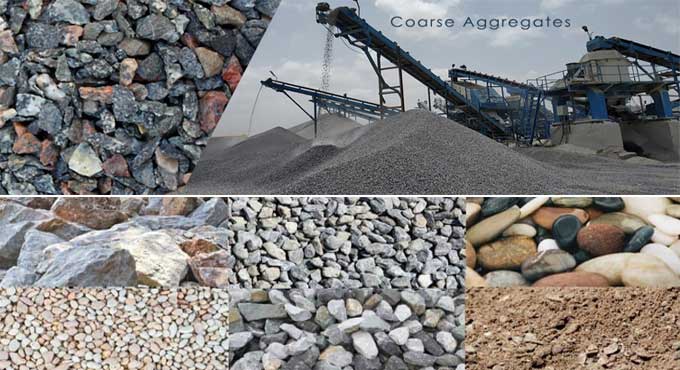
Unveiling the Power of Coarse Aggregates: Requirements, Uses, and Classification Explained

When it comes to construction materials, coarse aggregates play a vital role in providing strength, stability, and durability to various structures. These essential components, consisting of different types of rocks and stones, serve as the backbone of construction projects.
In this article, we will explore the requirements of good coarse aggregates, their versatile uses, the classification methods employed to identify and utilize them effectively, as well as their key features and methods of usage.
Classification of Aggregates
Aggregates can be classified based on size, density, and source. Size classification includes fine aggregates (sand), coarse aggregates (stones), and gravel. Density classification categorizes aggregates as lightweight, normal weight, or heavyweight. Source classification distinguishes between natural aggregates (quarried from rivers, lakes, or rock formations) and recycled aggregates (derived from demolished structures). These classifications aid in selecting the appropriate aggregates for specific construction needs.
Requirements of Good Coarse Aggregates
To ensure the quality and performance of coarse aggregates, several requirements must be met. Let's delve into the key factors that define good coarse aggregates:
1. Gradation: Good coarse aggregates should have a well-graded particle size distribution, with a balance of different sizes. This helps in achieving dense and cohesive concrete mixtures. A proper mix of coarse and fine aggregates ensures the reduction of voids and enhances the workability and strength of the concrete.
2. Strength and Durability: Coarse aggregates should possess sufficient strength to withstand the applied loads and resist deterioration due to environmental factors, such as freeze-thaw cycles, chemical exposure, and abrasion. The strength and durability of coarse aggregates are crucial for ensuring the longevity and structural integrity of the constructed elements.
3. Cleanliness: Coarse aggregates should be free from impurities such as clay, silt, organic matter, or other deleterious substances that may compromise the quality and performance of concrete. Impurities can weaken the bond between the aggregates and the cement matrix, leading to reduced strength and potential structural failures.
4. Hardness: Coarse aggregates must exhibit adequate hardness to ensure resistance against wear and tear, providing long-lasting structural integrity. Hardness is particularly important in applications such as road construction, where the aggregates must withstand the repetitive forces exerted by vehicular traffic.
Uses of Coarse Aggregates
Coarse aggregates find application in various construction projects, including:
1. Concrete Production: The primary use of coarse aggregates is in the production of concrete. By combining coarse aggregates with cement, sand, and water, a strong and durable building material is created that can withstand heavy loads and provide structural stability. The size and shape of coarse aggregates influence the workability, strength, and aesthetics of the concrete mixture.
2. Road Construction: Coarse aggregates are essential components in road construction. They are used as a base layer or sub-base material, providing a stable foundation for highways, roads, and pavements. The angular nature of coarse aggregates improves interlocking, enhancing the load-bearing capacity of the road surface and reducing the potential for rutting and deformation.
3. Railway Ballast: Coarse aggregates, particularly those with high strength and durability, are used as railway ballast. They support the tracks, distributing the load of trains and ensuring smooth transportation. The proper selection and placement of coarse aggregates as ballast help maintain track alignment, stability, and drainage, contributing to the safe and efficient operation of railways.
4. Drainage Systems: Coarse aggregates are employed in the construction of drainage systems, including French drains and septic tank leach fields. Their permeable nature allows for effective water drainage while preventing soil erosion. The void spaces between the coarse aggregates facilitate the flow of water, preventing the accumulation of excess moisture and maintaining the stability of the surrounding soil.
Features of Coarse Aggregates
1. Strength: Coarse aggregates provide strength to concrete and other construction materials, ensuring their ability to withstand applied loads and external forces.
2. Stability: Coarse aggregates enhance the stability and load-bearing capacity of structures by providing a solid foundation and interlocking properties.
3. Durability: Good coarse aggregates exhibit durability against environmental factors, ensuring the longevity and performance of constructed elements.
4. Permeability: Coarse aggregates used in drainage systems allow for effective water drainage, preventing the accumulation of excess moisture and maintaining soil stability.
Methods of Usage
1. Proper Mixing: Coarse aggregates should be properly mixed with other materials, including cement and fine aggregates, to achieve the desired concrete properties. The correct proportions and mixing methods should be followed to ensure uniform distribution and optimal performance.
2. Compaction: In road construction and other applications, coarse aggregates need to be compacted to achieve a dense and stable structure. Proper compaction methods, such as vibrating rollers, should be employed to ensure optimal compaction and interlocking of the aggregates.
3. Gradation Control: The size and gradation of coarse aggregates should be carefully controlled to achieve the desired properties of concrete or other construction materials. Sieves and grading techniques can be used to ensure the appropriate distribution of particle sizes.
To learn more, watch the following video tutorial.
Video Source: CE&T- Civil Engg & Technology
4. Surface Preparation: In applications such as road construction, the surface preparation of coarse aggregates is essential. This may involve cleaning, levelling, and compacting the subgrade before placing the coarse aggregates to ensure a smooth and stable surface.
Conclusion
Coarse aggregates are indispensable components in the construction industry, offering strength, stability, and durability to various structures. By meeting the requirements of gradation, strength, cleanliness, and hardness, they ensure the quality and performance of concrete. Moreover, their versatile uses in concrete production, road construction, railway ballast, and drainage systems highlight their importance in infrastructure development.
Understanding the classification of coarse aggregates based on size, density, and source aids in selecting the right aggregate for specific applications. Proper selection and utilization of coarse aggregates contribute to the longevity and reliability of constructed elements. By considering the key features and employing appropriate methods of usage, construction professionals can harness the power of coarse aggregates to create robust, enduring, and sustainable structures.


